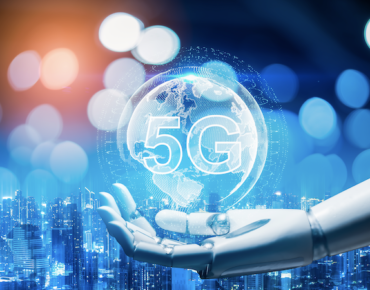Virtuous Cycle: AI Helps 5G Deliver Data for New AI Models

via Shutterstock
Artificial intelligence and 5G wireless are moving in tandem toward autonomous, self-healing networks able to maximize operational efficiency and reliability while leveraging new troves of network data to forecast bandwidth and power demands—all with “killer” low latency.
That’s the bullish forecast of AI backers and a leading wireless developer who say the disruptive technologies are moving “side-by-side” toward fully autonomous 5G networks by the end of the decade. AI and 5G are nothing less than “two faces of one gold coin,” said Mohamed Madkour, vice president of Huawei Technologies’ wireless and cloud unit.
The 5G equipment leader and target of U.S. export controls envisions “AI inside the full [5G technology] stack,” Madkour said.
Madkour described five levels of 5G network automation, the current level dubbed “conditional autonomy,” exhibiting the ability to execute commands and displaying a measure of network “awareness,” but still requiring human intervention.
AI-based “5G is a new capability,” Madkour added. That combination will not only boost performance and connectivity while greatly reducing latency but also super-charge cloud and edge computing platforms as well as the Internet of Things.
Many industrial applications could be delivered via private networks using leased spectrum to connect factory floors, added Neil Sahota, CIO of Global AI Initiatives.
Sahota also noted the symbiotic relationship between AI and 5G, the latter capable of delivering the growing amounts of data needed to train the very machine learning algorithms that will make possible autonomous 5G networks. Among the benefits of AI-driven 5G networks will be greater operational efficiency, Sahota added, including load balancing, predicting bandwidth demand for applications like popular streaming videos and energy management when bandwidth utilization drops.
“Smart automation” is another long-term goal for autonomous 5G networks, according to Will Townsend, an analyst with Moor Insights & Strategy. Among the operational efficiencies provided by AI-powered 5G networks is “predictive remediation,” in which potential outages can be identified before networks crash. “We are getting there with the help of AI,” Townsend said.
In one early example, Townsend said China Unicom (NYSE: CHU), among the world’s largest mobile service providers, is applying machine learning to network life-cycle management. As of June, the state-owed wireless carrier has reportedly deployed about 130,000 5G base stations across China, according to the Xinhau new agency.
Ultimately, Townsend said, the combination of AI and 5G will yield greater spectrum and power efficiency that will help carriers fulfill quality-of-service requirements as billions of new devices are connected to autonomous 5G networks.
The Global Mobile Supplier Association estimates a total of 92 5G networks have so far been deployed around the world.
Related
George Leopold has written about science and technology for more than 30 years, focusing on electronics and aerospace technology. He previously served as executive editor of Electronic Engineering Times. Leopold is the author of "Calculated Risk: The Supersonic Life and Times of Gus Grissom" (Purdue University Press, 2016).












